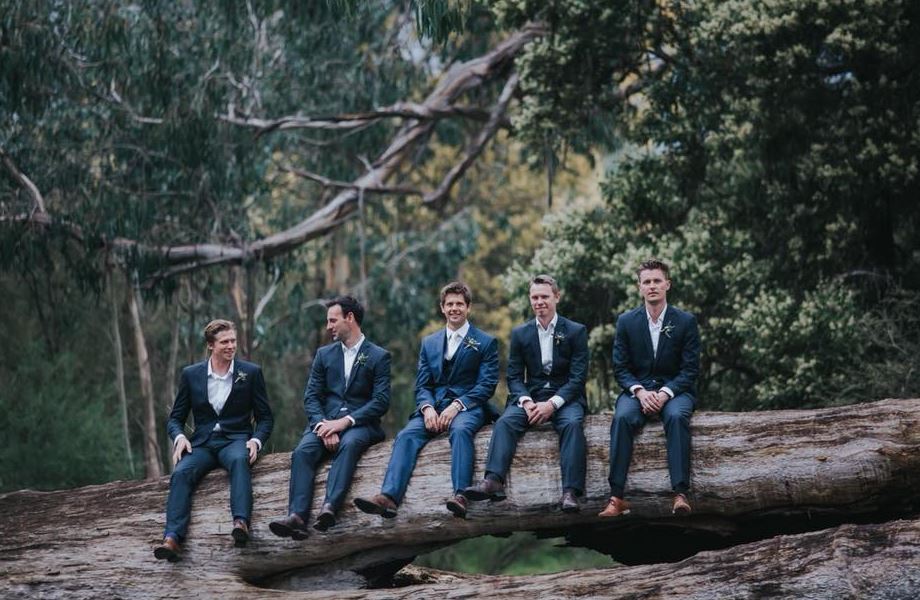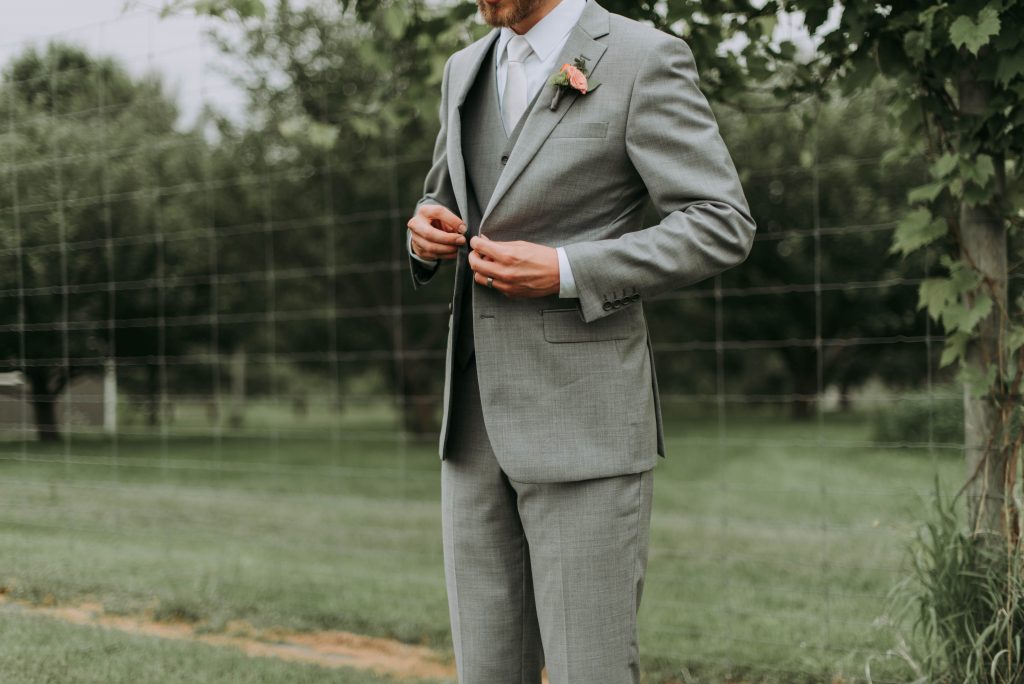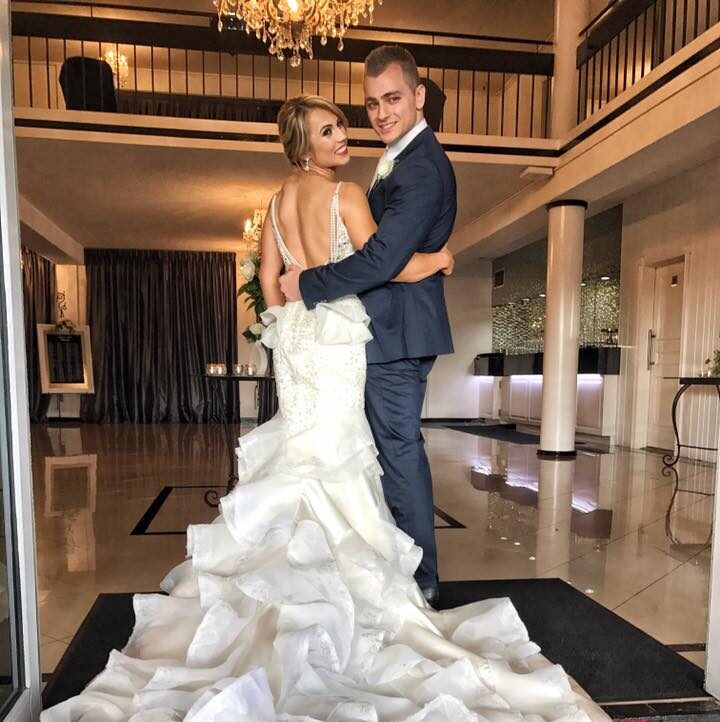Planning your wedding suit doesn’t have to be a last-minute scramble. Whether you’re opting for a classic groom suit or a more modern groom outfit, timing is everything. From choosing the perfect wedding blazer to ensuring the groom’s shoes and cufflinks are on point, the process involves more than just picking something off the rack. In this guide, we’ll walk you through when to start shopping, how to ensure the perfect fit, and share expert tips to help you look your best. Let’s make sure your suit is ready long before you walk down the aisle.
Why Timing Is Everything When It Comes to Your Groom Suit
Starting Early: The Key to a Stress-Free Wedding Day
When I got married, one thing I quickly realised was how much goes into planning a wedding. Between the venue, the guest list, the dress, and everything in between, the groom’s suit often gets pushed to the back burner. However, I can’t stress enough how starting early can save you a lot of stress down the line. In fact, I’d argue that getting your suit sorted early gives you more breathing room to focus on other parts of the wedding day.
For me I started thinking about my suit about 8 months out from the wedding. Sure, I had the usual questions floating around — would I go for a classic black tuxedo, or something a bit more modern? Should I go bespoke or rental? But once I got the ball rolling, I was able to enjoy the process without the last-minute panic. Believe me, having those early conversations with your partner and a skilled tailor ensures that you have plenty of time to tweak the details and make the right choices.
Experts often suggest starting the process 8–10 weeks before the wedding for a stress-free experience. But if you’re anything like me and prefer having a solid plan in place, starting 6-9 months in advance is ideal. It’s just enough time to explore options, do the necessary fittings, and still have plenty of flexibility to make changes if need be.
What Happens If You Wait Until the Last Minute?
Leaving your groom suit until the last minute isn’t just risky—it’s a surefire way to add unnecessary stress to what should be one of the happiest days of your life. I know a few grooms who waited until three weeks before the wedding to sort out their suits. Needless to say, the rushed experience led to some last-minute issues.
One friend of mine, let’s call him Dave, opted for a last-minute rental. The store had limited stock, and his size was nowhere to be found. After a mad scramble, he settled for a suit that wasn’t quite right, and it was an added stress he could have avoided. I remember him telling me, “If I had just started this a couple of months earlier, I wouldn’t have been stressing like this.”
If you’re buying a suit (especially if you want it tailored), you’ll likely need time for fitting adjustments, alterations, and multiple try-ons. So, don’t risk it. The last thing you want is to realise that your suit doesn’t fit quite right, and you don’t have time to fix it.
6 to 12 Months Before the Wedding: The Ideal Time to Start
Let me tell you, the earlier you start, the more enjoyable the whole process will be. If you’re after a made-to-measure suit or something bespoke, starting the process 6-12 months in advance is the best way to go. Not only does it give you ample time to explore fabric options, but it also allows for multiple fittings and adjustments. Plus, having this much time means you can enjoy the process, rather than rushing through it.
For example, I had a friend who went all-in on a custom, bespoke suit. He started his search a full 10 months before his wedding. He was able to pick out the exact fabric, design his own unique jacket lapels, and have several fittings along the way. The end result? A beautifully tailored suit that fit him perfectly and truly reflected his personal style. If he had waited until the last minute, he’d likely have missed out on some of the finer details he loved about the final look.
If you’re planning a destination wedding or if your wedding is during peak wedding season, starting 6-12 months before is a must. This timeframe gives you enough flexibility to deal with any challenges that come your way, whether it’s stock delays, shipping issues, or last-minute fittings.
4 to 6 Months Before: Narrowing Down Styles and Fittings
By the time you’re 4-6 months out, you should have a solid idea of the type of suit you want. At this stage, I suggest starting your first consultation with a tailor or suit shop to discuss fabrics, styles, and fit options. If you’re buying off-the-rack, this is a great time to make sure you’re choosing a suit that complements the style of the wedding and, more importantly, fits like a glove.
When I was planning my own wedding, I had narrowed down a few suit options but hadn’t yet decided on the final look. I made an appointment with a local tailor to discuss fabric choices and the overall fit, and by the end of that meeting, I was ready to commit. The consultation gave me a chance to voice my concerns about comfort and fit and get expert advice about how to make sure the suit would hold up during the ceremony and reception.
This is also a good time to start discussing accessories—the groom’s tie, cufflinks, and the groom’s shoes. Accessories can be a game-changer for your look, so don’t leave them to the last minute.
3 Months Before: Finalising Suit Choices and Measurements
By the time you’re three months out from the wedding, it’s go-time. This is when grooms should ideally be finalising suit details. If you haven’t already, now’s the time to lock in your measurements and make sure everything fits perfectly. If you’re renting, this is also when you should finalise rental arrangements to avoid any last-minute surprises.
I remember when I had my fitting three months before the big day, and while I had a rough idea of the fit I wanted, I was still adjusting some of the finer details. The jacket needed to be a little slimmer through the waist, and the trousers required a small length adjustment. If I had left it until a week before the wedding, those adjustments may have been too rushed, or worse, too late.
If you’re going made-to-measure or bespoke, the tailor will usually take a few measurements and begin cutting the fabric. Depending on your style and body shape, this process may require a couple of fittings before it’s perfect. Take the time now to check how the suit feels when you move. Ensure the shoulders fit comfortably and that the jacket sits right across the chest. I can’t stress enough how this phase is critical for your comfort and style.
Also, if you’re opting for a wedding vest or a wedding blazer, now’s the time to ensure these pieces are incorporated into your suit design. I remember feeling quite smart when I added a vest to my suit—it just made the whole look sharper and more formal. It’s a subtle touch but can make a big difference, especially for evening weddings.
2 to 3 Months Before: Renting or Ordering the Final Suit
At this stage, you should be ordering or renting your groom’s suit. This is one of the final stages where everything starts coming together. If you’re renting, the process usually involves picking a style, getting fitted, and ensuring your suit is available on the wedding day. The last thing you want is to find out that the tuxedo you want isn’t available in your size or colour. Rental shops can sometimes accommodate rentals up to 4–5 weeks in advance, but for peace of mind, 2-3 months is the ideal window.
If you’re buying your suit, this is when you’ll typically need to put in the final order. For bespoke or made-to-measure suits, now is the time to order your suit and set dates for the next fittings. It’s important to account for any shipping or delays in stock availability. A friend of mine recently ordered a luxury wedding suit, and even though he was told it would arrive in 6 weeks, a shipping delay pushed his fitting back by a couple of weeks, causing a bit of unnecessary stress.
By this stage, I recommend checking off your accessory list, too. Make sure you’ve ordered your groom’s tie, cufflinks, and anything else you plan to wear, such as a pocket square or suspenders. If you’re planning on wearing a bow tie, make sure it’s part of your final decision. These little accessories will give you that polished look, so don’t forget to pick them up ahead of time!
4 to 6 Weeks Before: Suit Collection, Final Fittings, and Adjustments
Alright, you’re getting close now. At the 4 to 6-week mark, your suit should be ready for final fittings. This stage is crucial because you want to make sure that everything fits just right. Don’t leave this until the last minute! This is your opportunity to address any issues—maybe the trousers need to be shortened slightly or the jacket needs to be taken in around the waist. Whatever it is, make sure to schedule your fitting far enough in advance so that any last-minute alterations can still be made.
When I went for my final fitting, I found that the trousers were just a tad too long. Luckily, I had time to have them hemmed, and they fit like a glove on the day. Trust me, there’s nothing worse than realising the morning of your wedding that your trousers don’t fit right.
This is also when you should be picking up any accessories like shoes, shirts, and socks. You want to make sure that everything works together—your shoes should complement the suit, and your shirt should fit snugly under the jacket without feeling too tight.
2 Weeks Before: Ready for Collection or Delivery
With just two weeks to go, your suit should be ready for collection or delivery. This is your final chance to try everything one last time. I remember when I went for my final try-on; it was so reassuring to see everything come together. The suit fit perfectly, and I was able to ensure that the groom’s cufflinks I ordered added that final elegant touch.
Use this time to double-check your accessories—does your groom’s tie still match your overall wedding colours? Do you need to pick up extra items like socks or a fresh pocket square? This is your last chance to make sure everything is in order. If you’re renting, you’ll likely be picking up the suit around this time, so it’s critical to make sure it fits and looks right.
I always suggest that grooms do a trial run in the suit—wear it for a couple of hours around the house, and see how comfortable it feels. This helps spot any issues, like tight cuffs or an uncomfortable shoe fit, before you get to the big day.
3 Days Before: Final Check and Collection for Rental Suits
For those renting a suit, 3 days before the wedding is often when the suit is ready for collection. Make sure to pick it up well in advance so you can make sure everything is in order. Take your groom’s shoes and try the whole ensemble together. Remember, if you’re renting, don’t forget to return the suit on time to avoid late fees. It’s best to set a reminder, so you’re not scrambling last minute.
Groom Suit Styles and Trends: What to Consider When Choosing Your Look
Classic vs. Modern Groom Suit: Which One is Right for You?
One of the first decisions I faced when picking my suit was whether to go for something timeless and classic or something with a modern twist. The choice can depend on a variety of factors, like your wedding venue, the formality of the event, and, of course, personal preference.
Classic suits, like a black tie wedding suit, are always in style. They’re sophisticated, elegant, and timeless. However, if you want something a little different, a modern groom suit could be the way to go. Modern suits can include a range of lighter fabrics, slimmer fits, and even unique colours like navy blue or charcoal grey.
The key is making sure the suit aligns with your personality and the tone of the wedding. A tuxedo with a sharp wedding jacket might suit a more formal wedding, while a lighter-coloured wedding blazer could be perfect for a beach or outdoor wedding. Remember, your wedding day is a reflection of you—your suit should tell that story.
Groom Suit Accessories: Ties, Cufflinks, and More
Must-Have Groom Accessories: Shoes, Ties, and Cufflinks
The groom’s tie, cufflinks, and shoes are often the final touches that elevate your look. While your suit may be the centrepiece of your attire, it’s these small details that add personality and polish.
When I was planning my wedding, I opted for a classic groom suit with a bow tie instead of a traditional tie. It added a vintage flair to my look, and I felt it gave my outfit an extra level of sophistication. The cufflinks I chose were simple but elegant, with a subtle engraving of my initials—something that felt personal but not too flashy.
While these accessories may seem minor, they can actually have a huge impact on your overall look. For example, matching the groom’s shoes to the formality of the event is essential. If you’re going for a black tie wedding suit, black patent leather shoes are a must. On the other hand, for a destination wedding suit, lighter, more breathable materials like leather loafers might work better.
Why Accessories Matter: Adding That Personal Touch
Accessories are your chance to add personality and style to your wedding look. Whether it’s a pocket square that adds a splash of colour or a tie bar that helps keep your tie in place, each piece is an opportunity to bring your unique flair to the day.
For example, my best man wore a pocket square in the same pattern as my tie, tying the whole group’s look together. It wasn’t something we planned meticulously; it just felt right when we were looking at the options. And to this day, I still look back and think, “That was a nice touch.”
Groom Suit Colours: What’s Trending in Wedding Suits
Picking the Right Colour for Your Wedding Suit
The colour of your suit will depend on a number of factors: the formality of the wedding, the season, and even the venue. Black will always be a classic and safe choice, especially for formal weddings or evening affairs. But I know plenty of grooms who have stepped outside the traditional bounds and embraced more modern hues, like navy blue, charcoal grey, or even bolder choices like deep green or burgundy.
When it came time to choose my wedding suit colour, I knew I didn’t want anything too dark for our afternoon garden wedding. I chose a light grey wedding suit, which felt fresh and contemporary but still elegant. It was also a great choice for the warmer weather, as it kept me cool throughout the day.
For couples opting for destination weddings, you might want to look at lighter fabrics and colours. Think linen wedding suits in ivory, light blue, or even sand tones. These colours are not only appropriate for tropical climates but also look fantastic against the backdrop of beaches or gardens.
How to Ensure Your Groom Suit Fits Perfectly: Tips & Expert Advice
The Importance of a Perfect Fit: Why It’s Worth the Wait
Getting a groom suit that fits properly isn’t just about appearance—it’s also about comfort. If you’ve ever worn a suit that’s too tight around the shoulders or too loose at the waist, you’ll know how uncomfortable it can be. On your wedding day, comfort is key. You’ll be moving around, hugging guests, dancing, and getting plenty of photos taken. A well-fitted suit will allow you to do all of this without feeling restricted.
When I had my suit made, I made sure to visit my tailor multiple times to check the fit. At the second fitting, the jacket sleeves needed to be shortened just a touch. It was a small adjustment, but it made all the difference. A suit that fits like it’s meant for you will not only make you feel more confident but also ensure that you’re comfortable all day long.
How to Avoid Common Fit Issues: Sleeves, Trousers, and More
One of the most common mistakes grooms make is not paying attention to the smaller details during fittings. For example, the length of your trousers should ideally just brush the tops of your shoes, not gather in a bunch at the ankles. Similarly, the sleeve of your jacket should hit just above the wrist, leaving a small sliver of your shirt cuff visible.
During my own fitting, I found that the trouser length wasn’t quite right. It was a minor detail that could have gone unnoticed if I hadn’t paid close attention. But after a quick adjustment, I was left with a pair of trousers that fit perfectly—no dragging, no bunching.
Additional Considerations for Your Groom Suit
Destination Wedding Suit Tips: What to Keep in Mind
Planning a destination wedding comes with its own set of challenges, and choosing the right suit for a far-flung location is one of them. If you’re getting married in a tropical locale or somewhere with a hot climate, the weight of your fabric is especially important. You’ll want something light and breathable, like linen or cotton.
When I was planning a friend’s destination wedding in Bali, we had to think carefully about the suit fabric. The groom ended up choosing a lightweight linen wedding suit in ivory, which was perfect for the warm weather and looked stunning against the beachfront setting. Not only was it breathable, but it kept him cool throughout the ceremony.
For those flying internationally, make sure to factor in potential shipping delays and the time difference when coordinating with tailors or rental shops. Starting early is key to making sure everything arrives in time.
Wedding Season and Peak Times: How to Plan Around Busy Periods
If you’re planning to get married during peak wedding season, be prepared for the added challenges of booking fittings and securing the best suits. The wedding season can lead to longer waiting times for appointments, and tailors or suit rentals can get fully booked up, especially for popular months like November and December.
I recall during one wedding season, a groom I worked with started his suit search in July for a December wedding. By then, many of the best suit options in his size were sold out. The delay meant he had fewer choices for a formal wedding suit, and he had to settle for a suit that didn’t feel as great as the one he originally wanted. Plan well in advance to avoid that kind of stress.
Accessories and Last-Minute Tips for a Flawless Look
Must-Have Groom Accessories: Shoes, Ties, and Cufflinks
I’m sure I don’t need to remind you, but groom shoes are just as important as your suit. A great suit can be ruined by a pair of old, scuffed shoes. When choosing shoes, make sure they’re comfortable because, let’s face it, you’ll be on your feet for a long time. I personally recommend Oxfords or Derby shoes for a classic look. These are comfortable for long days and versatile enough to pair with almost any suit style.
Don’t forget the little things—cufflinks, tie bars, and a pocket square can all elevate your overall look. These small details are what make a suit truly personalised. Whether you go for sleek, understated cufflinks or something more eye-catching, it’s the accessories that will make your suit pop.
Last-Minute Tips: How to Ensure Everything is Ready for the Big Day
Two weeks out, ensure that your groom suit is ready for the big day. Double-check that all your accessories have arrived. The day before the wedding, give your suit one last check, steam out any wrinkles, and make sure everything fits properly. I always recommend having a backup plan—if you’re wearing a tie, bring an extra one just in case, or have a backup shirt ready.
A Stress-Free Groom Suit Shopping Experience
- Start Early: Begin looking for your suit 6-12 months before the wedding to avoid last-minute stress.
- Tailor to Fit: Whether renting or buying, ensure the suit fits perfectly to avoid discomfort on the big day.
- Accessorise: Don’t overlook the importance of ties, cufflinks, and shoes in pulling your look together.
- Plan for Destination Weddings: Be mindful of climate and shipping considerations if you marry abroad.
- Keep an Eye on the Calendar: Be aware of the wedding season to ensure you get the best suit options with enough time.
Let’s Get Straight to the Point
Timing is crucial when choosing your groom suit. Start planning 6-12 months before the wedding for a custom or made-to-measure suit, with fittings and final adjustments made around 2-3 months in advance. Renting a suit should be arranged 2-3 months before to ensure availability. Early planning helps avoid stress, ensures a perfect fit, and allows for last-minute adjustments. Accessories like cufflinks, ties, and shoes should be coordinated, and the suit should be checked again 2 weeks before the big day. Don’t leave it until the last minute to avoid rushed alterations and limited choices.




